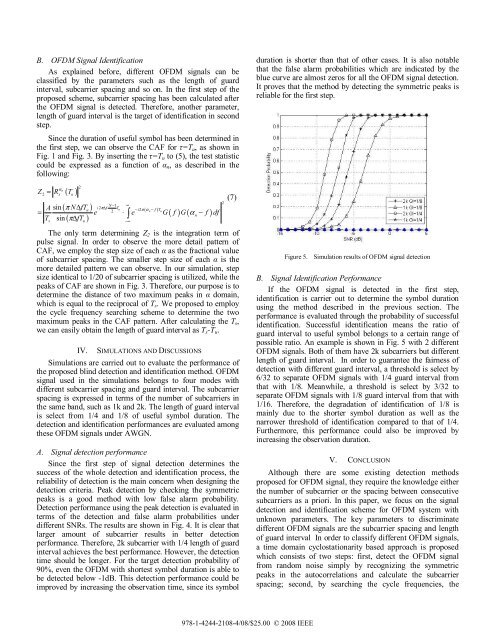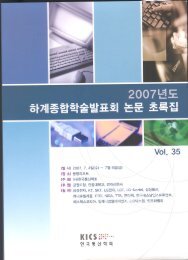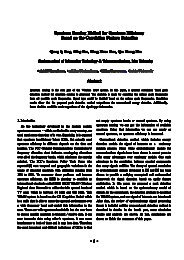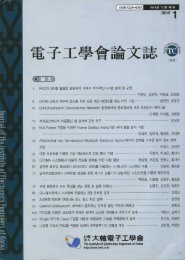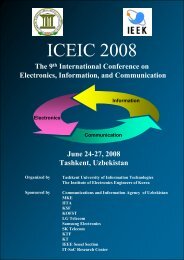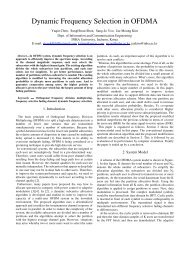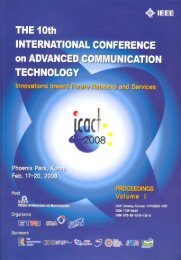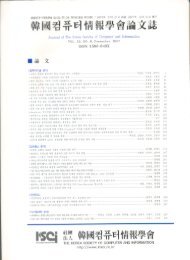Cyclic Autocorrelation based Blind OFDM Detection and ...
Cyclic Autocorrelation based Blind OFDM Detection and ...
Cyclic Autocorrelation based Blind OFDM Detection and ...
Create successful ePaper yourself
Turn your PDF publications into a flip-book with our unique Google optimized e-Paper software.
B. <strong>OFDM</strong> Signal Identification<br />
As explained before, different <strong>OFDM</strong> signals can be<br />
classified by the parameters such as the length of guard<br />
interval, subcarrier spacing <strong>and</strong> so on. In the first step of the<br />
proposed scheme, subcarrier spacing has been calculated after<br />
the <strong>OFDM</strong> signal is detected. Therefore, another parameter,<br />
length of guard interval is the target of identification in second<br />
step.<br />
Since the duration of useful symbol has been determined in<br />
the first step, we can observe the CAF for =Tu, as shown in<br />
Fig. 1 <strong>and</strong> Fig. 3. By inserting the =Tu to (5), the test statistic<br />
could be expressed as a function of n, as described in the<br />
following:<br />
2<br />
( )<br />
Z = R T<br />
αn<br />
x u<br />
2<br />
( π N∆fTu) ( π∆<br />
)<br />
N −1<br />
∞<br />
A sin<br />
i2π∆f Tu<br />
2<br />
−i2π( αn−<br />
f ) Tu<br />
= e ⋅ e G( f ) G( α n − f ) df<br />
T sin fT <br />
s u<br />
−∞<br />
The only term determining Z2 is the integration term of<br />
pulse signal. In order to observe the more detail pattern of<br />
CAF, we employ the step size of each as the fractional value<br />
of subcarrier spacing. The smaller step size of each is the<br />
more detailed pattern we can observe. In our simulation, step<br />
size identical to 1/20 of subcarrier spacing is utilized, while the<br />
peaks of CAF are shown in Fig. 3. Therefore, our purpose is to<br />
determine the distance of two maximum peaks in domain,<br />
which is equal to the reciprocal of Ts. We proposed to employ<br />
the cycle frequency searching scheme to determine the two<br />
maximum peaks in the CAF pattern. After calculating the Ts,<br />
we can easily obtain the length of guard interval as Ts-Tu.<br />
IV. SIMULATIONS AND DISCUSSIONS<br />
Simulations are carried out to evaluate the performance of<br />
the proposed blind detection <strong>and</strong> identification method. <strong>OFDM</strong><br />
signal used in the simulations belongs to four modes with<br />
different subcarrier spacing <strong>and</strong> guard interval. The subcarrier<br />
spacing is expressed in terms of the number of subcarriers in<br />
the same b<strong>and</strong>, such as 1k <strong>and</strong> 2k. The length of guard interval<br />
is select from 1/4 <strong>and</strong> 1/8 of useful symbol duration. The<br />
detection <strong>and</strong> identification performances are evaluated among<br />
these <strong>OFDM</strong> signals under AWGN.<br />
A. Signal detection performance<br />
Since the first step of signal detection determines the<br />
success of the whole detection <strong>and</strong> identification process, the<br />
reliability of detection is the main concern when designing the<br />
detection criteria. Peak detection by checking the symmetric<br />
peaks is a good method with low false alarm probability.<br />
<strong>Detection</strong> performance using the peak detection is evaluated in<br />
terms of the detection <strong>and</strong> false alarm probabilities under<br />
different SNRs. The results are shown in Fig. 4. It is clear that<br />
larger amount of subcarrier results in better detection<br />
performance. Therefore, 2k subcarrier with 1/4 length of guard<br />
interval achieves the best performance. However, the detection<br />
time should be longer. For the target detection probability of<br />
90%, even the <strong>OFDM</strong> with shortest symbol duration is able to<br />
be detected below -1dB. This detection performance could be<br />
improved by increasing the observation time, since its symbol<br />
2<br />
(7)<br />
978-1-4244-2108-4/08/$25.00 © 2008 IEEE<br />
duration is shorter than that of other cases. It is also notable<br />
that the false alarm probabilities which are indicated by the<br />
blue curve are almost zeros for all the <strong>OFDM</strong> signal detection.<br />
It proves that the method by detecting the symmetric peaks is<br />
reliable for the first step.<br />
Figure 5. Simulation results of <strong>OFDM</strong> signal detection<br />
B. Signal Identification Performance<br />
If the <strong>OFDM</strong> signal is detected in the first step,<br />
identification is carrier out to determine the symbol duration<br />
using the method described in the previous section. The<br />
performance is evaluated through the probability of successful<br />
identification. Successful identification means the ratio of<br />
guard interval to useful symbol belongs to a certain range of<br />
possible ratio. An example is shown in Fig. 5 with 2 different<br />
<strong>OFDM</strong> signals. Both of them have 2k subcarriers but different<br />
length of guard interval. In order to guarantee the fairness of<br />
detection with different guard interval, a threshold is select by<br />
6/32 to separate <strong>OFDM</strong> signals with 1/4 guard interval from<br />
that with 1/8. Meanwhile, a threshold is select by 3/32 to<br />
separate <strong>OFDM</strong> signals with 1/8 guard interval from that with<br />
1/16. Therefore, the degradation of identification of 1/8 is<br />
mainly due to the shorter symbol duration as well as the<br />
narrower threshold of identification compared to that of 1/4.<br />
Furthermore, this performance could also be improved by<br />
increasing the observation duration.<br />
V. CONCLUSION<br />
Although there are some existing detection methods<br />
proposed for <strong>OFDM</strong> signal, they require the knowledge either<br />
the number of subcarrier or the spacing between consecutive<br />
subcarriers as a priori. In this paper, we focus on the signal<br />
detection <strong>and</strong> identification scheme for <strong>OFDM</strong> system with<br />
unknown parameters. The key parameters to discriminate<br />
different <strong>OFDM</strong> signals are the subcarrier spacing <strong>and</strong> length<br />
of guard interval In order to classify different <strong>OFDM</strong> signals,<br />
a time domain cyclostationarity <strong>based</strong> approach is proposed<br />
which consists of two steps: first, detect the <strong>OFDM</strong> signal<br />
from r<strong>and</strong>om noise simply by recognizing the symmetric<br />
peaks in the autocorrelations <strong>and</strong> calculate the subcarrier<br />
spacing; second, by searching the cycle frequencies, the


